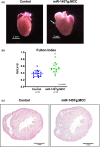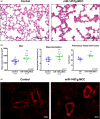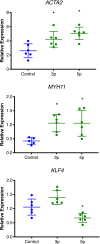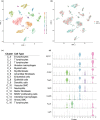miR-145 transgenic mice develop cardiopulmonary complications leading to postnatal death
- PMID: 34523259
- PMCID: PMC8440944
- DOI: 10.14814/phy2.15013
miR-145 transgenic mice develop cardiopulmonary complications leading to postnatal death
Abstract
Background: Both downregulation and elevation of microRNA miR-145 has been linked to an array of cardiopulmonary phenotypes, and a host of studies suggest that it is an important contributor in governing the differentiation of cardiac and vascular smooth muscle cell types.
Methods and results: To better understand the role of elevated miR-145 in utero within the cardiopulmonary system, we utilized a transgene to overexpress miR-145 embryonically in mice and examined the consequences of this lineage-restricted enhanced expression. Overexpression of miR-145 has detrimental effects that manifest after birth as overexpressor mice are unable to survive beyond postnatal day 18. The miR-145 expressing mice exhibit respiratory distress and fail to thrive. Gross analysis revealed an enlarged right ventricle, and pulmonary dysplasia with vascular hypertrophy. Single cell sequencing of RNA derived from lungs of control and miR-145 transgenic mice demonstrated that miR-145 overexpression had global effects on the lung with an increase in immune cells and evidence of leukocyte extravasation associated with vascular inflammation.
Conclusions: These data provide novel findings that demonstrate a pathological role for miR-145 in the cardiopulmonary system that extends beyond its normal function in governing smooth muscle differentiation.
Keywords: miR-145; cardiovascular; pulmonary; smooth muscle differentiation.
© 2021 The Authors. Physiological Reports published by Wiley Periodicals LLC on behalf of The Physiological Society and the American Physiological Society.
Conflict of interest statement
The authors have declared no conflicts of interest.
Figures







References
-
- Ahlfeld, S. K., Gao, Y., Wang, J., Horgusluoglu, E., Bolanis, E., Clapp, D. W., & Conway, S. J. (2013). Periostin downregulation is an early marker of inhibited neonatal murine lung alveolar septation. Birth Defects Research. Part A, Clinical and Molecular Teratology, 97, 373–385. 10.1002/bdra.23149. - DOI - PMC - PubMed
-
- Ahlfeld, S. K., Wang, J., Gao, Y., Snider, P., & Conway, S. J. (2016). Initial suppression of transforming growth factor‐β signaling and loss of tgfbi causes early alveolar structural defects resulting in bronchopulmonary dysplasia. The American Journal of Pathology, 186, 777–793. 10.1016/j.ajpath.2015.11.024. - DOI - PMC - PubMed
-
- Anderson, J. P., Dodou, E., Heidt, A. B., De Val, S. J., Jaehnig, E. J., Greene, S. B., Olson, E. N., & Black, B. L. (2004). Hrc is a direct transcriptional target of mef2 during cardiac, skeletal, and arterial smooth muscle development in vivo. Molecular and Cellular Biology, 24, 3757–3768. - PMC - PubMed
Publication types
MeSH terms
Substances
Grants and funding
LinkOut - more resources
Full Text Sources
Medical
Molecular Biology Databases

